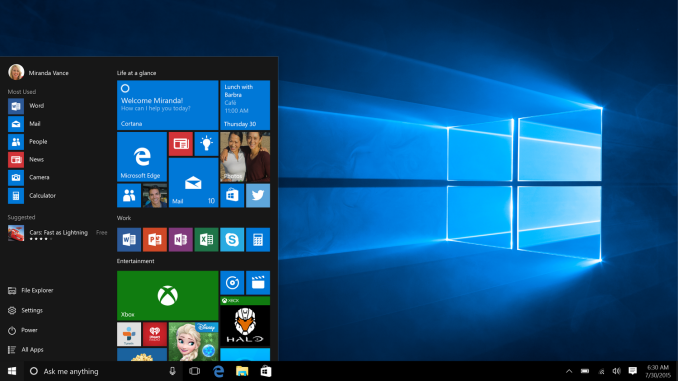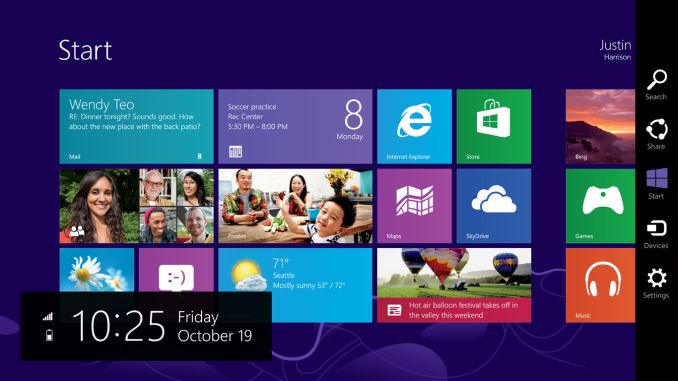The Windows 10 Review: The Old & New Face of Windows
by Brett Howse on August 25, 2015 8:00 AM EST- Posted in
- Operating Systems
- Microsoft
- Windows 10

Let’s flash back to 2012. About three years ago, Windows 8, the last major release of Microsoft’s ubiquitous operating system, was released to manufacturers. This was to be Microsoft’s most ambitious release yet. Traditional PC sales were in decline, and more personal devices such as the iPad tablet were poised to end the dominant PC platform. Microsoft’s response to this was to change Windows more than in any previous release, in a bid to make it usable with the tablet form factor. Windows 8 launched in October 2012 to much fanfare.
There was much fanfare, but little in the way of sales. Yes, Microsoft did sell many copies of Windows 8, but it did not help the declining PC market rebound. Windows 8 came to be with a touch first interface, with a new Start Screen replacing the traditional Start Menu, and a new breed of Windows 8 apps, which run on the WinRT framework. These WinRT apps have been named many things over the past three years, starting with Metro apps. A trademark dispute ended that naming scheme though, and over time they have morphed from full screen apps to universal apps to Windows Store apps, and practically none of them were able to rival the older Win32 platform in popularity or productivity.
Windows 8 did bring some great features to Windows, but they were overshadowed by the major design shift which, while good as a touch based operating system, alienated many who still used Windows on a traditional desktop or notebook. The Start Screen was a big turn off to many people, and full screen apps were not very efficient on a large screen display. Even the multitasking in Windows 8 was less than ideal, with the initial release only allowing two Windows Store apps to be open at any one time, and the second was relegated to a small side bar.
Microsoft’s own faith in Windows 8 was clearly not strong. Only a couple of weeks after Windows 8 launched, they unceremoniously dumped the project head Steven Sinofsky from the company, and spent the next two years trying to make Windows 8 more usable on traditional mouse and keyboard type machines, which were the vast majority of Windows devices in the hands of users. Windows 8.1 arrived and fixed some of the key issues with Windows 8, and 8.1 Update launched with the ability to boot to the desktop, and avoid the touch interface almost completely if you wanted to.
 Windows 10 Start Menu and Desktop view
Windows 10 Start Menu and Desktop view
When looking at Windows 10, I think it is pretty important to look back over the last three years, because none of this is ever built or designed in a vacuum. Microsoft has a huge number of devices running Windows, but a large majority of them are running Windows 7, which was an evolutionary desktop upgrade. Windows 8 struggled to ever take over any of that usage share. Windows 10 is Microsoft’s attempt to bridge the divide. Windows 7 is used by hundreds of millions of people, but its touch support is practically zero. Windows 8 works well in a touch scenario, but is not ideal for keyboard and mouse based devices. Windows 10 promises to be the version of Windows which bridges this gap.
Windows 10 brings about as much change as Windows 8 did, but in almost all cases it is going to be appreciated by users rather than avoided. It will run on a dizzying number of device types, including the traditional desktop, notebook, tablet, two-in-one, phone, IoT, Raspberry Pi, Hololens, Surface Hub, and even Xbox One. What it will bring to each of those device types is not the single interface that Windows 8 pushed on the desktop, but a unified app platform. Each device type will have its own interface, but the underlying app platform will allow developers to target a huge number of devices. And developer buy-in is the one thing Microsoft needs more than any other in order to make this vision succeed. For all of Windows 8’s quirks, it was really the lack of quality apps in the Windows Store which was the one hurdle Microsoft could not code around. Only time will tell whether or not the new model succeeds where the old one failed, but at the beginning of the life of Windows 10 we can go through all aspects of it and see what’s new, what’s changed, and how it fits in on today’s devices.











293 Comments
View All Comments
lilmoe - Thursday, August 27, 2015 - link
Well if it works using Linux, then what's the problem?emilemil1 - Tuesday, August 25, 2015 - link
The "Share a OneDrive link" button isn't something new, it's been there on both Win7 and 8 for like a year now.http://arstechnica.com/information-technology/2014...
Brett Howse - Tuesday, August 25, 2015 - link
So I may be mistaken on the exact dates it came to 8.1, but it was in Windows 10 in the first release on October 1st. I don't recall seeing it added to 8.1 before that. Anyway regardless nice find I'll add a note in the review.piasabird - Tuesday, August 25, 2015 - link
A lot of these features in Windows 10 can simply be turned off. Some of them can be turned off during the initial boot up and install by selecting the advance settings and turning them off. I will admit that some of the settings seem to be hidden a bit or simply are in a different place. Some of the Internet settings that affect the browser cant be accessed inside of Edge?BMNify - Tuesday, August 25, 2015 - link
upgraded my windows 8.1 laptop to 10, looks like a good improvement and Cortana is awesome.bernstein - Tuesday, August 25, 2015 - link
The spyware aspect of this OS bothers me. I'll be using Windows 7 until this is reconsidered.Oxford Guy - Tuesday, August 25, 2015 - link
They're pushing out loads of "updates" that add the spyware in.sadsteve - Tuesday, August 25, 2015 - link
Well, all I can say is that the GUI, start menu, privacy and update issues have motivated me to seriously look at linux for my main machine for day to day activities. Most of the applications I currently use are open source or cross platform (Libre Office, jEdit, eclipse, Firefox, Thunderbird, etc) so making the switch shouldn't be too hard. Probably do dual boot so I have access to all my steam games and PhotoShop.wavetrex - Friday, August 28, 2015 - link
You're not alone brother...I've been a die-hard "windowser" since the days of Win 3.0, always saying "linux sux, it's behind, can never do the things windows does... etc."
Mint 17.2 'Rafaela' runs now on my 2nd SSD soooo smoothly. Moving more and more activities to it every day.
I guess that gaming will be the last one to "die" on winblowz.
Mr Perfect - Tuesday, August 25, 2015 - link
Does the stylus input only work with printed handwriting, or can it parse cursive? If it can digitize cursive, I could see it being very quick. The difference between on-screen keyboards and printing with individual letters would be close to a wash, though.